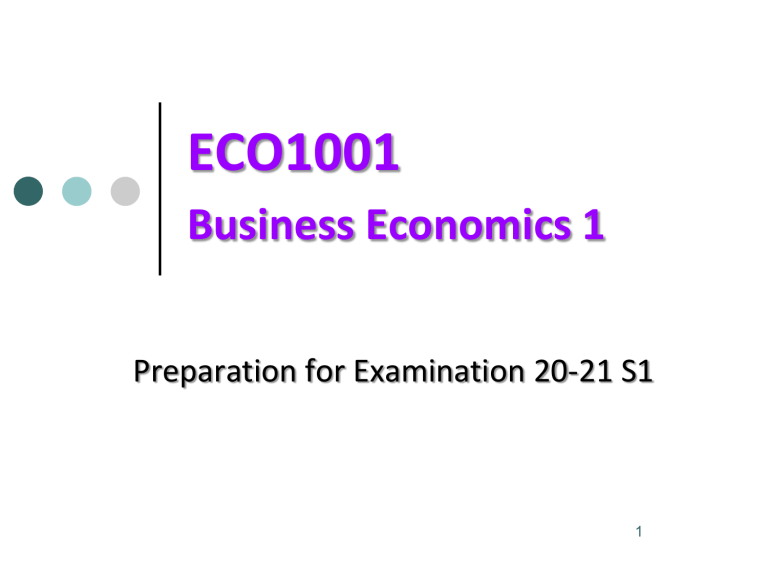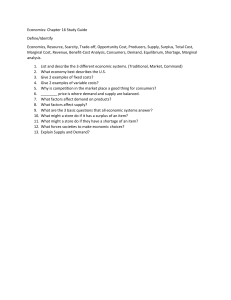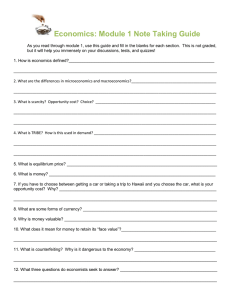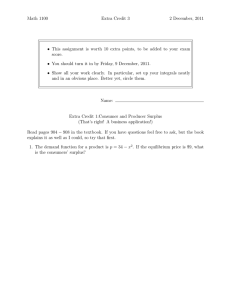
ECO1001 Business Economics 1 Preparation for Examination 20-21 S1 1 Final Examination Date: 10 Dec 2020 10 hours (10:30-20:30) Scope: Topic 1-11 Section A (20%): 20 Multiple Choice Questions Section B (80%): 6 Structured Questions All questions are compulsory! Plan your time well! 2 Attendance (From Student Handbook) Students whose attendance of a module is less than 80% are not allowed to attend the End-ofModule examination. ⚫ The Registry will notify you by email if you were NOT allowed to take the final exam. 3 Make-up Examination (From Student Handbook) Under normal circumstances, students who fail to sit for the end-of-module examination without prior approval will receive Fail grade of the relevant module. Students are required to retake the module if they are unable to attend the End-ofModule examination. NO make-up examination will be arranged for them! 4 Recall the Assessments Quizzes (4% x 5) Assignments (6% x 5) Final Exam 20% 30% 50% 100% 5 Final Examination: Section A Do 20 MC Questions on the Moodle platform named (2020-1) [Assessment] ECO1001 Business Economics 1 MCQs are randomly generated from the MC question bank Covers all topics Only attempt once Time limit: 40 minutes 6 Final Examination: Section B • • • Do 6 Structured Questions Download the exam paper from the Moodle platform named (2020-1) [Assessment] ECO1001 Business Economics 1 Answer sheets Students are expected to write answers on the answer sheets. Submit the scanned copy of handwritten answers in ONE pdf file to the same Moodle platform Typed answers are NOT marked On-line submission deadline: 10 December at 20:30 Late submission is not accepted. 7 Tips for YOU! 8 Section A: 20 MC questions (20%) Attempt the problem sets in Moodle Attempt the exercises in MindTap Re-do the tutorial qtns in the lecture PPT Do the ECO1001 Exam Revision 20S1 (Section A) 9 Section B: Q1 T/F Statements (20%) Question 1 contains 4 T/F statements Each statement carries 5 marks To get the full mark, you have to: State your STANCE: True or False ⚫ Define and explain the KEY concept tested in the statement ⚫ Explain why the statement is true or false ⚫ Sometimes you may use diagrams to assist your explanations 10 ⚫ Section B: Q2 – 6 Application Qs (60%) Questions are in the style of Problem & Application Questions in the textbook (in MindTap), assignments and tutorial qtns in the lecture PPTs Each question has more than 1 part Each question carries different marks (8 – 15 marks) Total marks for Q2 – 6: 60 marks 11 Topic Highlights 12 Topic 1 Introduction & Overview (Ch.1 & 2) Ch.1 10 Principles of Economics How people make decisions Principle 1: People Face Trade-offs ⚫ Principle 2: The Cost of Something is What You Give Up to Get it ⚫ Principle 3: Rational People Think at the Margin ⚫ Principle 4: People Respond to Incentives ⚫ 13 Topic 1 Introduction & Overview (Ch.1 & 2) Ch.1 TEN Principles of Economics How people interact Principle 5: Trade Can Make Everyone Better Off ⚫ Principle 6: Markets Are Usually a Good Way to Organize Economic Activity ⚫ Principle 7: Governments Can Sometimes Improve Market Outcomes ⚫ 14 Topic 1 Introduction & Overview (Ch.1 & 2) Ch.2 Thinking Like an Economist Economist as Scientist Scientific Method: Observation, Theory, & Test Role of Assumptions Normative Economics Vs Positive Economics 15 Topic 2 Interdependence & Gains from Trade (Ch 3) Production Possibility Frontier (PPF) ⚫ Definition ⚫ Slope of PPF: opportunity cost ⚫ Shape of PPF: linear ⚫ Efficiency ⚫ Economic growth 16 Topic 2 Interdependence & Gains from Trade (Ch 3) Absolute Advantage vs Comparative Advantage Lower opportunity cost → Comparative advantage → Specialization → Higher total output → Higher consumption Table (Calculation) & Diagram (PPF) Terms of trade 17 Topic 3 The Basics of Demand & Supply (Ch 4) Demand vs Quantity Demanded (Table & Diagram) Law of Demand Change in Demand vs Change in Quantity Demanded (Table & Diagram) Factors affecting Change in Demand 18 Topic 3 The Basics of Demand & Supply (Ch 4) Supply vs Quantity Supplied (Table & Diagram) Law of Supply Change in Supply vs Change in Quantity Supplied (Table & Diagram) Factors affecting Change in Supply 19 Topic 3 The Basics of Demand & Supply (Ch 4) Equilibrium: P & Q (Table & Diagram) Disequilibrium: Shortage & Surplus (Table & Diagram) Change in D &/or Change in Supply → Change in Equilibrium P & Q (Table & Diagram) How prices (invisible hand) allocate resources 20 Topic 4 Elasticities (Ch 5) If P increases, how much will Qd decrease? Smaller? Bigger? Price elasticity of demand (Ed) ⚫ Definition ⚫ Calculation & meaning ⚫ Demand & Ed ⚫ Total revenue & Ed (Calculation & Diagram) (e.g. P decreases & Q increases, will TR increase?) 21 ⚫ Factors affecting Ed Topic 4 Elasticities (Ch 5) Price elasticity of supply (Es) ⚫ Definition ⚫ Meaning ⚫ Supply & Es ⚫ Factors affecting Es 22 Topic 5 Market Efficiency (Ch 7) Buying decision: (Table) ⚫ WTP (Value) = P at the margin → max Consumer Surplus (CS) ⚫ CS = WTP (Value) – P Demand & WTP (Diagram) ⚫ CS = Area under D & above P Selling decision: (Table) ⚫ MC = P at the margin → max Producer Surplus (PS) ⚫ PS = P - MC Supply & Cost (Diagram) 23 ⚫ PS = Area under P & MC curve Topic 5 Market Efficiency (Ch 7) Market efficiency (Table & Diagram) ⚫ D & S → P → Resource allocation → Max Total Surplus ⚫ WTP (value) = P = MC at the margin 24 Topic 6 Government Interventions (Ch 6 & 8) Chapter 6 Supply, Demand, & Government Controls of Price ⚫ Price floor • Definition • Binding if price floor > equilibrium price • Table & Diagram ⚫ Price ceiling: • Definition • Binding if price ceiling < equilibrium price • Table & Diagram 25 • Non-price competition Topic 6 Government Interventions (Ch 6 & 8) Chapter 6 Supply, Demand, & Government Taxes ⚫ How taxes on sellers (Buyers) affect market outcomes (P & Q) ⚫ Elasticities of demand & supply & tax incidence (more elastic demand than supply → buyers are more sensitive to price change than sellers → smaller price increase but larger price decrease → buyers bear less tax burden than sellers) ⚫ Table & Diagram 26 Topic 6 Government Interventions (Ch 6 & 8) Chapter 8 The Costs of Taxation How does a tax affect consumer surplus, producer surplus, and total surplus Deadweight loss (DWL) of taxation (Diagram) 27 Topic 7 Cost of Production (Ch 13) Opportunity costs: implicit & explicit costs Economic profit Vs Accounting profit Production function: input-output relationships (Table & Diagram) ⚫ MP & TP ⚫ Diminishing MP (Short-run) Cost of production: output-cost relationships (Table & Diagram) ⚫ SR: fixed & variable costs; inverse relation between MC & MP; short-run cost curves ⚫ LR: LRATC curve; economies & diseconomies of 28 scale Topic 8 Firms in Competitive Markets (Ch 14) Features of a competitive market Price taker P = AR = MR & TR (Table & Diagram) Short Run (Table & Diagram) ⚫ Rules for Maximization (MR=MC given P covers AVC → Q) ⚫ Profit & loss ⚫ Short-run Supply curve (individual 29 firm & market) Topic 8 Firms in Competitive Markets (Ch 14) Long Run (Table & Diagram) ⚫ Rules for Maximization (MR=MC given P covers ATC) ⚫ Entry & exit ⚫ Long-run equilibrium (P=ATC) SR Vs LR Efficiency of a competitive market 30 Topic 9 Monopoly (Ch 15) Why does a monopolist arise? Downward sloping market demand & P > MR (Single price monopoly) (Table & Diagram) Profit maximization (MR=MC) → P, Q, profit or loss (Table & Diagram) No supply curve Welfare cost of monopoly (DWL) (P>MC → higher P & lower Q) (Diagram) Price discrimination: same good, different prices to different buyers Perfect price discrimination (Vs Single price monopoly) 31 (P=WTP for each unit) (Table & Diagram) Topic 10 Monopolistic Competition (Ch 16) Features of monopolistic competition: many sellers, differentiated product, free entry & exit Downward sloping demand & P > MR Monopolistic competition vs Monopoly vs Perfect competition 32 Topic 11 Oligopoly & Game Theory (Ch 17) Strategic behaviour: cooperation (collusion → cartel) vs self-interest Oligopoly vs Monopoly vs Perfect Competition Game Theory ⚫ ⚫ ⚫ ⚫ ⚫ Players Strategies Payoff matrix Dominant strategy? Nash equilibrium? (one type: prisoners’ dilemma) 33 Sample Questions See (and practice) ECO1001 Exam Revision 20S1 34






